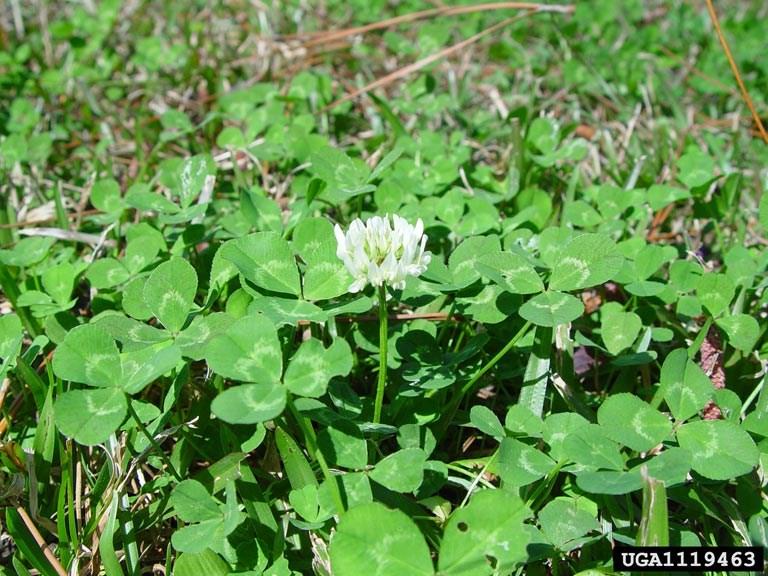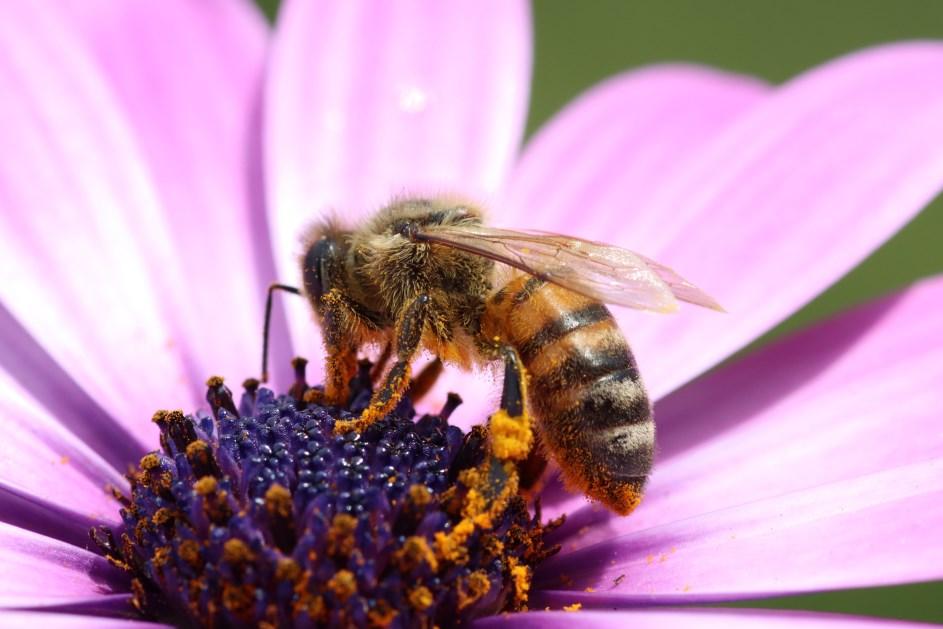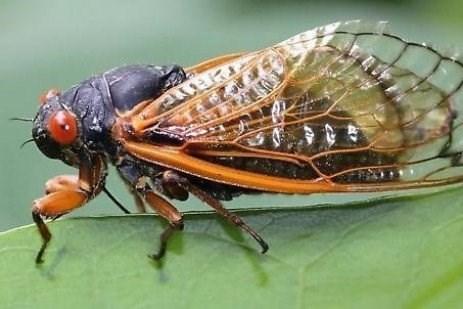
13 minute read
St. John’s Wor t
White clover. Photo credit: Chris Evans, University of Illinois, Bugwood,org
The following chart may be useful in distinguishing the three look-alikes:
Advertisement
All three of these look-alikes are turfgrass weeds that can be reduced through improving the quality and thickness of your lawn. It may be of interest to note that white clover was included in grass seed mixes until the development of broadleaf herbicides in the 1950s. At that point it became a goal of the herbicide companies to influence homeowners to have a "perfect" lawn, free from all broadleaf weeds, including white clover.
It is with good reason that white clover was historically considered part of a healthy lawn. Like other members of the legume family, it takes nitrogen from the air and "fixes" it into its root system. This nitrogen becomes an available fertilizer for the grass. This symbiotic relationship reduces or can even eliminate the need for supplemental nitrogen fertilizer. White clover will fill in empty spots in the turf, reducing other weeds and the need for chemical herbicides. White clover greens up early in the spring and, being drought tolerant, stays green during the hot, dry, dog days of summer. Consider including white clover in your lawn just because it is an important nectar source for many pollinators. White clover is also a very valuable forage crop. Rabbits, and other wildlife, will browse it in the garden. If you have members of your household who are allergic to bee stings, you can always reduce the number of flowers by mowing beneath their height, which can reach 6 inches.
Plant
Yellow woodsorrel
Growth
Habit
Prostrate, becoming more erect
Flower
Yellow
Leaf
Smooth margins; deep indentation at tip; heart-shaped
Black medic Prostrate: mat-shaped; does not have nodes Yellow inflorescence Spur at tip; center leaflet has longer petiole; pair of stipules at base of leaf stem
White clover Prostate growth from center crown; roots at nodes White, sometimes pinkish, inflorescence Serrated margins; slight indentation at tip; white, V-shaped watermark
St. John's Wort Hypericum perforatum F. Hypericaceae
General Description:
St. John's wort is a low-lying herb measuring 30-75 cm. in height. The radially symmetrical flowers have bright yellow petals with distinctive black dots. The leaves are small, elliptical, and spotted.
Flowers:
The radially symmetrical flowers of St. John's wort are small, measuring 2-2.5 cm. in width. The blooms have five rounded petals with distinctive black spots, numerous stamens, and 3 styles. Flowers are arranged singly atop the terminal shoot of the stem.
Leaves:
The leaves are small, measuring 2.5-5 cm. in length and are light green and elliptical with distinctive, translucent spots/irregularities. Leaves are arranged in an opposite fashion along the length of the stem.
Habitat:
St. John's wort grows best in fields, along roadsides, and around waste areas.
Fun Facts:
St. John's wort is a medicinal plant. Commercial pill forms of the plant extract is used to treat depression. However, it causes increased sensitivity to the sun as well.
St. John's wort also causes photodermatitis in grazing animals.
This wildflower was introduced from Europe.
Source: http://www.bio.brandeis.edu/fieldbio/ Wildflowers_Kimonis_Kramer/PAGES/SEARCH_NAME_HOME.html
Gardeners Reminded to Protect Pollinators
By Rosie Lerner, Extension Consumer Horticulture Specialist, Purdue University

Pollinators are all the “buzz” these days with a federal proclamation designating June 19-25 as National Pollinator Week. Now in its tenth year, the focus of this designation by the U.S. Departments of Agriculture and the Interior is to promote the health of pollinators, so critical to food and ecosystems.
It may surprise you to learn that the honeybee is native to Europe and was introduced to the U.S. But there are also numerous other pollinator species including native bees, butterflies and moths, beetles, birds and bats. Many pollinators have suffered from loss of habitat, chemical misuse, diseases and parasites.
Gardeners play a critical role in the nurturing and conservation of both native and introduced pollinators. Gardens and landscapes provide pollinators with food, water, shelter and habitat to complete their life cycles. Urban areas typically feature large areas of pavement and buildings and offer little in the way of food or shelter for pollinators – garden plantings can help bridge the gap.
Honeybees and other pollinators need protein from flower pollen and carbohydrates from flower nectar. Plan to provide a variety of different types of flowers, and aim to have three different flower species in bloom throughout the growing season. Showy, colorful flowers and massed groups of flowers, particularly in small gardens, provide efficient feeding stations for the pollinators. Flowering trees and shrubs also provide excellent food sources.
Pollinators also need shelter from wind, scorching sun and heavy rains. Plants, garden structures such as fences, and windbreaks may make the garden more attractive to pollinators. Pesticides can harm bees and other pollinators directly or may change their behavior or reproductive potential. Some chemicals make pollinators more susceptible to disease.
You can protect pollinators by using alternative prevention and control strategies, such as hand-picking pests, mulching and by being selective when it becomes necessary to use pesticides.
Read and follow all label directions, and pay particular attention to timing your application to minimize impact on pollinators. Generally, bees and others are less active in very early morning or at dusk. Choose spray rather than dust formulations of pesticides to lessen potential for contact. Avoid using pesticides in areas where pollinators are likely to forage. Maintain a buffer “no-spray area” when possible. Wait until flowers have faded (petal -fall) before applying. Mow the lawn to remove flowers of weeds before spraying.
Want to learn more? Here are a couple of selected resources on pollinators: Purdue Extension Publications on Pollinator ProtectionProtecting Pollinators in Home Lawns and Landscapes is targeted to homeowners. It is available at https://edustore.purdue.edu/item.asp? Item_Number=POL-1
Protecting Pollinators in Fruit and Vegetable Production is aimed at commercial vegetable growers. It is available at https://edustore.purdue.edu/item.asp? Item_Number=POL-2
National Pollinator Week http://pollinator.org/pollinatorweek/
(Continued from page 10)
What’s going on here? Researchers believe that the high intensity of outdoor light influences how children’s eyes develop, essentially affecting how clearly they can see. Without enough exposure to outside light, their eyes are not able to develop properly. Although currently there are no clear-cut solutions, researchers hypothesize that the best medicine may be more time playing outdoors, especially for younger children.
The take-home message: Too much near work and not enough outside play have affected children’s sight during the COVID-19 pandemic. The first step to solving this problem is simple: Get kids to spend more time outside.
Visit Cornell University’s Bronfenbrenner Center for Translational Research’s website for more information on our work.
Boiling it Down: Adding Broth to Your Pet’s Meals
Should I add broth to my pet’s meals?
Though not necessary for most pets, incorporating a broth into the diet can be a way to provide added moisture to pets that need it or as a low calorie treat. For starters, especially pets that need to watch their total calorie intake, diluting a small amount of broth with water and freezing it into a Kong toy or ice-cube tray can add variety to your pet’s diet without adding many calories. Broth can also sometimes help entice a picky pet to eat. However, it is recommended that you consult your veterinarian to make sure there is no underlying medical condition causing your pet to lose its appetite. Broth can also be a great way to add moisture to your pet’s food in some cases such as pets with a history of urinary stones.

Regardless of the reason, it is important to make sure that adding broth won’t interfere with special diets. For example, if your pet is on a strict diet due to allergies, or a special formula to reduce bladder stones, adding broth may prevent these diets from working therapeutically.
What product should I use?
While there are many commercial broth products, it is important to look at the ingredients list closely. Even “low sodium” -branded broths may be too high in sodium levels, so using commercial broth is not recommended in pets with medical conditions. Also be sure to check for other ingredients in commercial broths that may be yummy to us but are toxic to pets! Onions or garlic, especially in a concentrated form like powders, can cause vomiting and the breakdown of healthy red blood cells which can make pets very ill, so it’s safest to avoid any products with these ingredients.
Can I make my own?
Since commercial broths can vary so widely and often have undesirable or even unsafe ingredients, it’s generally lowest risk to make your own broth at home. The safest recipe is boiling unseasoned meat or vegetables in plain water to form a basic broth. However, because there is no way to determine the nutrient profile of your homemade broth, owners should always consult their veterinarian to make sure the ingredients you use are not harmful for your pet.
Take-Away: Adding broth to your pet’s food can be a tasty, low calorie addition to your pet’s diet. But as with any diet change, it is always important to consult your veterinarian first!
Why are grapes toxic?
While you may have heard before to not feed grapes or raisins to your dogs for fear of kidney damage, the reason why they can be so toxic has been a mystery. However, recently a new idea has emerged that might finally help us figure out what is going on! A group of veterinarians from the ASPCA Animal Poison Control Center and two hospitals described in a letter to the editor of the most recent Journal of the American Veterinary Medical Association that tartaric acid (which cream of tartar is made from) may be the part of grapes that cause them to be toxic to pets. The amount of tartaric acid can vary in grapes by their type, how they were grown, and how ripe they are, which could explain why some pets get very sick while others seem unaffected after eating similar amounts of grapes or raisins. There is still a lot of research and work still to do, but here’s more on this new hypothesis.
When should I be worried?
Studies looking at the amount of grapes and raisins needed to cause problems have shown there is a large range and each dog can respond differently. This may be in part to how grapes change throughout the ripening process and we need more studies to know how best to treat dogs that have eaten grapes or raisins. If you are worried that your dog may have eaten any food item or medication that could harm them, you should call your veterinarian and an animal poison control center, such as the ASPCA’s animal poison control, that can help determine how concerned you should be and guide treatment recommendations.
How is this related to snacks for dogs?
While many fruits and vegetables can be great snacks for pets, you should avoid feeding pets grapes and raisins. Until we know more about whether tartaric acid is the cause of grape toxicity, and, if so, what doses could be harmful to dogs, it is probably a good idea to avoid giving your dog commercial or homemade foods with cream of tartar as an ingredient at this time. Cream of tartar can be found in many baked goods, so it can be helpful to check the ingredient list before deciding to share a treat with your pets. This is an additional reason to be extra cautious with homemade play dough recipes that can often include cream of tartar along with very high levels of salt (and these high salt levels can cause neurologic issues and be life-threatening)! We have also seen a few homemade dog treats (including the dog version of human snickerdoodle cookies) that contain cream of tartar as one of the ingredients, so you should always check homemade dog treat recipes to ensure that they do not contain any toxic ingredients before making them for your furry friends.
cicadas. While stragglers may emerge a few days earlier or later, the main emergence of a periodical cicada brood often occurs over one or just a few nights.
Soon after emerging, males begin to sing while females remain silent. About 10 days after emergence, females mate and begin depositing eggs in twigs and branches of various trees and woody shrubs. Using a saw-like ovipositor, a female cicada cuts a small pocket into a twig, in which she deposits 24-28 eggs. She then moves forward, cuts another pocket, and lays more eggs. The pockets are placed close together in a straight row and sometimes form a continuous slit for 2-3 inches. Adult periodical cicadas live for 3-4 weeks above ground and each female can lay 400-600 eggs over a lifetime. The eggs hatch 6-7 weeks after they are laid. The white-ant-like nymphs work their way out of the twig slits, drop to the ground, and enter the soil where they feed on fluids from plant roots for the next 17 years.
Since, periodical cicadas are clumsy fliers and easy prey for a variety of birds and other insect-eating predators. Mass emergence of them is therefore thought to be a form of predator avoidance – if millions of cicadas emerge at the same time, predators quickly eat their fill and leave the vast majority of them alone to reproduce. Early or late-emerging cicadas are generally not numerous enough to successfully reproduce because most of them are eaten. While individual periodical cicadas typically live for 13 or 17 years, mass emergences of periodical cicadas usually happens somewhere in the eastern United States every year.
Cicadas do not bite or sting and are not a threat to people or pets, although consumption of large numbers by pets should be discouraged. However, they can do damage to young trees, that results in twig and stem dieback. Large, otherwise healthy trees, can withstand this damage without long-term consequences, although they may be aesthetically unpleasing for a time. Small trees that have a majority of the branches within the cicadas' preferred size range can be severely affected and sometimes be killed. This is especially true of small, stressed trees, such as those that have been recently transplanted or are balled and burlapped in preparation for sale or transplantation. Deciduous trees are preferred hosts, especially oaks, maples, apples, cherry, hawthorn, redbud and other trees that have twigs of the appropriate size (3/16” to 7/16” in diameter), although cicadas are not too picky and have been recorded to oviposit in more than 80 different species. Shrubs are rarely harmed. Also, they do not target herbaceous plants (annuals and perennials, including vegetables and herbs) for feeding or egg-laying. They do not usually deposit eggs in coniferous trees, although coniferous hosts are not totally unknown. Ornamental ponds should be covered with screening or plastic mesh to prevent cicadas from accumulating. Large numbers of decomposing cicadas could cause problems with oxygen depletion in the water. Clean pool skimmers/filters frequently during cicada emergence to keep them from getting clogged.
Control - If possible, transplanting trees should be avoided the fall and spring before a periodical cicada emergence. Pruning trees should also be avoided during this time as branches injured by cicadas can be pruned out after they die off. Trees under 10-feet tall can be protected by netting with 1/2” mesh, or a breathable fabric, to exclude the cicadas. Apply before emergence and keep on the 4-6 weeks they're present. In most cases, netting trees is more effective than spraying chemical pesticides. However, chemical pesticides can be used to reduce damage to small trees when netting is not practical, such as in a large fruit orchard. The pesticide is often needed to be applied every 2-3 days as new cicadas immigrate from nearby trees. But chemical pesticides can also kill beneficial mites and insects, which can exacerbate pest issues later in the season. Pesticides are not recommended for large, otherwise healthy trees, as they can withstand the pressure of cicada oviposition with little to no long-term effects.

Periodical cicada (Magicicada cassini). Photograph by Even Dankowicz via Bugguide. Used under a CC BY-ND-NC 1.0 license.
References: “Periodical Cicada”; Penn State Extension “Cicadas”; University of Maryland Extension
Did you ever notice when you blow in a dog's face he gets mad at you? But when you take him in a car he sticks his head out the window. ~Steve Bluestone



